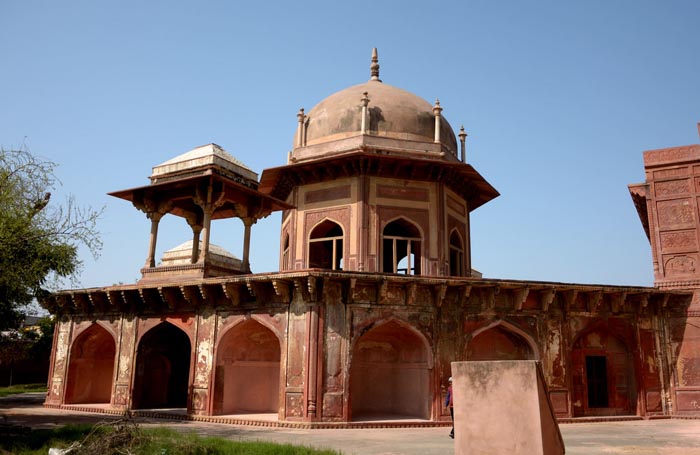Firoz Khan Tomb

Information on Firoz Khan Tomb (Agra, Uttar Pradesh) - History & Architecture
Situated in few miles from Agra, the Tomb of Firoz Khan lies on the west side of a big water reservoir. The catacomb is dedicated to Firoz Khan who was the warden of king Shahjahan and served him devotedly. Firoz Khan created this tomb throughout his life span and labelled it accordingly. Although some portion of the monument was destroyed, at present it is protected by the 'Archaeological Survey of India'.
Firoz Khan Tomb Architecture
Tomb of Firoz Khan stands unique in the history of Mughal architecture. It was completely created by red sandstone. Furthermore, grey stonework is also used with red sandstone in order to generate lovely colour effect. Stone carving is the only prominent architecture that can be found in the construction of the tomb. It uses highly systematised arabesque and floral designs in stone statues. A double storeyed gate lead to the tomb which is linked with the eastern side of the main building. The plan of the entire structure was quite unique and simple. There is an extensive staircase which lead to the first floor. The first floor is the main storey of the monument. On the other hand, the ground floor is only a subsidiary storey which comprise the tomb of Firoz Khan.
Tomb of Firoz Khan is supported by luxuriantly carved brackets and is engrained by a hemispherical vault, which is fringed on the angles by pinnacles. The dome was initially gazed surfaced. The most imposing aspect of the tomb is the two storeyed entryway which possesses open arched compartments and two umbrella based superstructures. These structures which have been demolished in present times. The entire peripheral mural surface of the entrance has been panelled and bears curved niches. It comprise urn and greenery configurations in high relief. The most noticeable aspects of the entrance are the panels on northern and southern sides. They demonstrate lotus architecture with beautiful scroll decorations.
The terrace of Tomb of Firoz Khan is in octagonal shape, having two pillared rectangular structures on northern and southern sides. The central rotunda which comprises a memorial is also octagonal shape. It possesses curved openings on every sides and seven of which leave the entrance on southern side. The western side of the tomb has a curved designed mosque with brackets and glassy covered roofs.
Firoz Khan Tomb History
As stated above, Firoz Khan was the noble of Shahjahan. However, initially he served under Mughal emperor Jahangir. During the realm of Shahjahan, Firoz Khan was liable for the regal harem until his death. While historical records acclaim a garden which was constructed by Firoz Khan on the bank of river Jhelum. Yet, he is remembered for his red sandstone tomb which is situated in a penned enclosure of a huge tank. On that time, many other individuals have created their tomb before death and thus, Firoz Khan was also motivated by such act and developed his own tomb during his lifetime. He died in the year 1647 and after his death, the tomb labelled as Tal Firoz Khan. Amanat Khan is the one who designed the entrance of the tomb and also created the mosque inside it.
Firoz Khan Tomb Tourism Importance
Overall, Tomb of Firoz Khan is a great example of Mughal architecture. It demonstrates the architectural features during the period of Shahjahan which makes it a significant tourism site. Its red sand stonework along with various structures is worth visiting.
- Andaman Nicobar Monuments
- Andhra Pradesh Monuments
- Assam Monuments
- Bihar Monuments
- Chhattisgarh Monuments
- New Delhi Monuments
- Goa Monuments
- Gujarat Monuments
- Haryana Monuments
- Himachal Pradesh Monuments
- Jammu and Kashmir Monuments
- Karnataka Monuments
- Kerala Monuments
- Madhya Pradesh Monuments
- Maharashtra Monuments
- Odisha Monuments
- Punjab Monuments
- Rajasthan Monuments
- Tamil Nadu Monuments
- Telangana Monuments
- Uttar Pradesh Monuments
- West Bengal Monuments